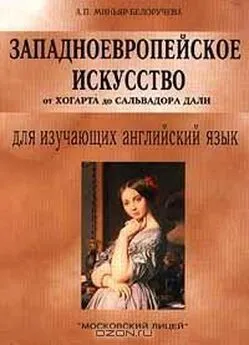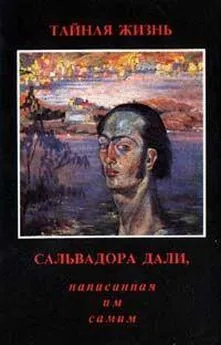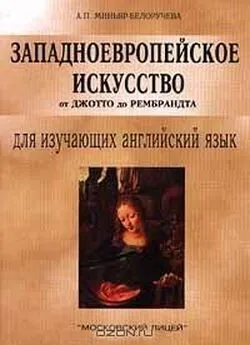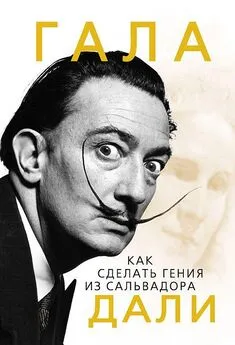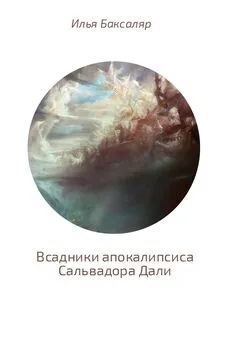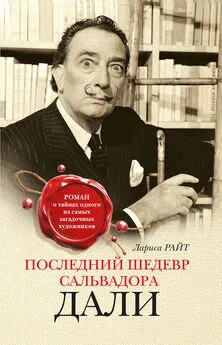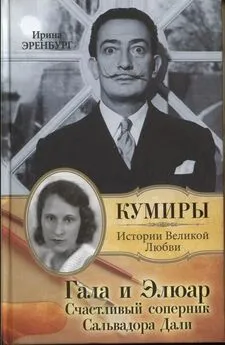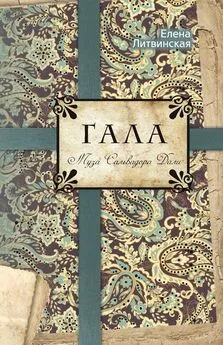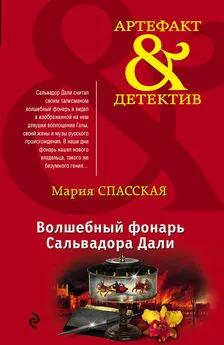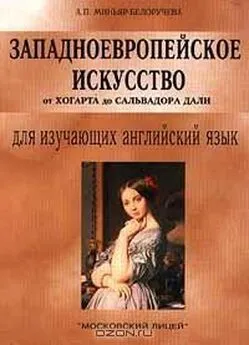Алла Миньяр-Белоручева - Западноевропейское искусство от Хогарта до Сальвадора Дали
- Название:Западноевропейское искусство от Хогарта до Сальвадора Дали
- Автор:
- Жанр:
- Издательство:«Московский Лицей»
- Год:1999
- Город:Москва
- ISBN:5-7611-0182-3
- Рейтинг:
- Избранное:Добавить в избранное
-
Отзывы:
-
Ваша оценка:
Алла Миньяр-Белоручева - Западноевропейское искусство от Хогарта до Сальвадора Дали краткое содержание
Тексты настоящего пособия охватывают почти три века истории западноевропейского искусства от Хогарта до Сальвадора Дали. Это позволяет обучаемым наряду с усвоением обширного лексического материала, приобрести культурологические знания, поскольку тексты содержат информацию о жизни и творчестве крупнейших западно-европейских художников XVIII – XX вв. Система упражнений направлена на усвоение лексического материала и развитие навыков устной речи.
Данная книга является второй частью цикла учебных пособий «Западноевропейское искусство (для изучающих английский язык)». В первую книгу вошли тексты, охватывающие пять веков западноевропейской живописи oт Джотто до Рембрандта. Данное пособие предназначено для студентов-искусствоведов, учащихся классических гимназий, лицеистов и всех изучающих английский язык и интересующихся западноевропейским искусством.
Западноевропейское искусство от Хогарта до Сальвадора Дали - читать онлайн бесплатно полную версию (весь текст целиком)
Интервал:
Закладка:
In 1943 Matisse moved to the Riviera hill-town of Vencc, where during a serious illness he was cared for by Dominican nuns. In gratitude he designed and financed a wonderful chapel for them. He created architecture, murals, stained glass, vestments the altar, candlesticks, and crucifix, between 1948 and 1951. Despite the fact that Matisse professed no formal religion, this chapel is one of the few greatest works of the religious art done in the twentieth century.
Although in old age Matisse was confined to bed, his scope and freedom of art widened. Zulma, of 1950, is dominated by blue, green and pink. Its pulsating contours, flat surfaces and brilliant colour revive on a new scale the energy of Matisse's Joy of Life . To many critics Matisse remain, from a purely pictorial stand point, the most sensitive painter of the twentieth century.
Make sure you know how to pronounce the/allowing words:
Henry Matisse; Nice; Vence; nun; Fauve; Fauvism; Oriental; bouquet; distortion; Dominican; forehead; triumphant; decorative
The Green Stripe – «Зеленая полоса»
Joy of Life – «Радость жизни»
Red Studio – «Красная комната»
Decorative Figure Against an Ornamented Background (Nude with the Straight Back) – «Декоративная фигура на фоне орнамента» (Обнаженная с прямой спиной)
Zulma – «Зульма»
I. Read the text. Make sure you understand it. Mark the following statements true or false.
1. Matisse was an amateur painter.
2. In 1900 came the explosion of Cubism.
3. Matisse's new scale and contour were prepared by Gauguin.
4. Matisse reached Gauguin's primitivism only with reference to exotic cultures.
5. In 1943 Matisse took up residence at Nice, where he created a series of masterpieces.
6. Matisse is considered to be the most sensitive painter of the twentieth century.
II. How well have you read? Can you answer the following questions?
1. What innovations interested Matisse? What experiments did Matisse perform? What attracted Matisse then?
2. Why did The Green Stripe excite horror? What is depicted in this painting?
3. What is the triumphant affirmation of Matisse's Fauve period? What did Matisse reach in this picture?
4. What did Matisse write in 1908? What painting sums up Matisse's art and philosophy? What was the idea of this picture? What has survived as an echo in this painting?
5. What did Matisse create in 1921? What is typical of Matisse's Nice period? What is represented in this painting?
6. What did Matisse do in 1943? What did he create between 1948 and 1951? What did Matisse produce in his old age?
III. i. Give Russian equivalents of the following phrases:
the innovations of the Post-Impressionists; simplified figures; the art world; the celebrated group of Fauve pictures; to intensify the differentiation of hues; to produce a strong emotional effect; to intensify the fluidity of contour; exotic culture; a delicate web of line and colour; stained glass; from a pictorial stand point.
ii. Give English equivalents of the following phrases:
упрощенные формы; перспектива Ренессанса; знаменитые работы фовистов; утонченная изысканность линии и контура; витраж; экзотическая культура; произвести сильный эмоциональный эффект; подчеркнуть плавность линий; мир искусства; с точки зрения живописи; усилить контраст тонов.
iii. Make up questions of your own with the given phrases.
iv. Arrange the following in the pairs of synonyms:
a) contour; vestment; masterpiece; mural; touch; revive;
b) artistic scene; style; masterwork; recover; shape; garment
IV. Here are descriptions of some of Matisse's works of art. Match them up to the titles given below.
1. This painting is dominated by blue, green and pink.
2. A forest glade is inhabited by a happy company of nudes, male and female, embracing, playing pipes and picking flowers.
3. Renaissance perspective survives here only as an echo.
4. The strongly modelled, grandly simplified forms of the nude are played off against the movement of the Rococo shapes in the wallpaper and the mirror.
5. The blazing bouquet of colours was applied not only to the background but also to the face.
6. It is a great work of art of the 20-th century.
a. Red Studio
b. Zulma
c. The Green Stripe
d. The Chapel
e. Decorative Figure Against an Ornamented Background (Nude with the Straight Back)
f. Joy of Life
V. Translate the text into English.
Анри Матисс, самый талантливый из фовистов, прошел через увлечение импрессионистами и в поисках интенсивности и яркости цвета пришел к упрощенности и плоскости форм. Предметом изображения Матисса служат самые простые мотивы: цветы, кресла, ткани. В его полотнах почти нет объема, композиции строятся на контрасте цветов. Линии у Матисса очень лак9нич-ны. «Матисс-декоратор» – это особая страница монументально-декоративной живописи первой половины XX в. Одна из последних его работ – декоративное оформление капеллы в Вансе.
VI. Summarize the text.
VII. Topics for discussion.
1. Matisse's artistic philosophy.
2. Matisse's mature works of art.
Unit XVIII Picasso (1881-1973)
The long career of Pablo Ruiz у Picasso cast across the twentieth century a shadow as long as those of Michelangelo and Titian across the sixteenth century. Picasso created one of the most important movements of the twentieth century, participated in many others, and influenced every phase of artistic activity throughout the world in one way or another until his extreme old age. Throughout his entire life he showed an incredible range of ideas and styles, and even in later years he remained a towering figure. The best works among his immense output have taken their place among the masterpieces of twentieth-century art.
A fully trained painter at the age of nineteen, the Spanish-born Picasso took up residence in France in 1900. He fell under the influence of Toulouse-Lautrec. Picasso became concerned with the lives of those who lived as he did on the periphery of society. The woman in his Absinthe Drinker , of 1902, is enveloped in self-pity and helplessness, a figure of extraordinary sculptural simplicity and beauty. The painting is coloured by blue – the proverbial colour of melancholy – which has given its name to this period in Picasso's evolution, lasting about four years (1901-4). For the young painter it was a period of hopeless maladjustment to the art world of Paris.
By late 1904 Picasso's mood of depression had lightened, and so also had his palette. A brief Rose Period (1904-6) followed, in which he was less concerned with the tragic aspects of poverty than with the nostalgic charm of circus performers. Salimbanques , of 1905, shows a family of these strolling players grouped together physically, but emotionally detached, before a mysterious desert landscape. Figures and costumes, surely drawn and modelled blend with the ground and the sunny haze in tones of softly greyed blue, rose and beige, creating mother-of-pearl effects. This is one of the loveliest pictures of the 20-th century.
Les Demoiselles d'Avignon , of 1907, heralds the beginning of Cubism. The attitude and methods of the Cubists are not easy to explain. Cezanne had founded planes in real objects and had used them to establish a structure of form seen by means of colour; the Cubists do the opposite, imposing their own structure of mono-chromic planes upon the object. The composition of Les Demoiselles d'Avignon was derived from a small bather composition by Cezanne. The intensity of the partially decomposed figures contrasts with a still life in the foreground. Instead of Cezanne's lovely roses, blues and greens, the figures are largely light brown, their anatomy is indicated by uneven white or black contours. A harsh blue, as if a sudden glimpse of sky, surrounds the figure at the upper right. The staring expressions of the central figures give way at all sides to simplified, influenced by African sculpture, faces.
Heads, busts, still life and occasional landscapes form the subject matter of early Cubist painting. In the Seated Woman , of 1909, the individual forms – the characteristic swelling and distortion of the neck muscles, or the reduction of the eyes to trapezoids – are not derived from nature. Soft tans and olive tones prevail.
By 1911, in the phase known to art historians as Analytical Cubism, the tension has burst, and so has the object. The entire foreground is filled with its component planes, floating as if in a thick mist. The planes are no longer opaque; one seems to see through them, and a great deal of the effect of an Analytical Cubist picture is derived from the delicacy of the intersection of these planes. They are rendered with a divided touch recalling that of Impressionism. These planes build up a pyramidal structure, superseding the structure of observed reality.
Cubism rapidly became a common style. During 1912 the Cubist artists began to turn to a new series of interests and a new kind of experience, responsible for the phase known generally as Synthetic Cubism, since the painters no longer sought to disintegrate the object but to reassert it. In Synthetic Cubism the barrier between reality and representation is unexpectedly broken. Now bits of the real objects make their entrance into the picture: newspaper clippings, lengths of rope, etc. Picasso's The Bottle of Suze , of 1913, is an epitome to this Synthetic phase. Once established, the Cubist mode of vision and construction continued vital for many years. Every abstract current in abstract art during the period from the 1920s to the present owes a debt to Cubism. For the rest of his life Picasso continued to make use of Cubist forms and ideas.
During the years immediately after World War I, it is not possible to talk of «periods» in Picasso's work; two sharply different styles, superficially opposed, but in reality strongly related to each other, exist side by side. The gorgeous Three Musicians , of 1921, is a Synthetic Cubist picture in that the planes are, now locked into a total design, governed by the recognisable image. The three musicians are undoubtedly a Pierrot, a Harlequin and a Franciscan monk. The planes into which they have been divided proceed according to their own laws and not those of natural appearances. The colouring is as brilliant as that of any Fauve painting. Its hard clear tones together with the astonishing size create a splendid decorative effect.
In 1917 Picasso visited Italy. He was greatly impressed by the grandeur of the Italian past, especially Roman sculpture and the mural paintings of Giotto. Quite unexpectedly Picasso developed a monumental and largely monochromatic Classical style with complete figures heavily modelled as if they were statues. He experimented with every aspect of Classical style, but his most imposing Classical creations are the majestic compositions involving seated giantesses seeming to derive from a legendary past. In Three Women at the Spring , of 1921, Picasso has made the figures graceless, emphasising the bulk and weight of their hands and feet, and intensifying the impersonality of their stony faces. For several years this Classical style coexisted in Picasso's production with late Cubism.
Читать дальшеИнтервал:
Закладка:
